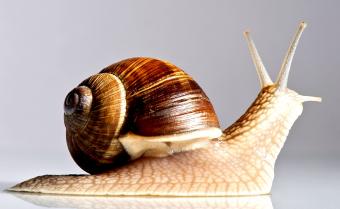
No matter if you find snails slimy or scintillating, these snail facts for kids will surprise and delight you. If you've ever wondered if snails are related to slugs, what these slow-moving creatures eat, or about the animals that hunt them, we're shelling out fun facts about snails that are sure to fascinate you!
Wonderful & Weird Snail Facts for Kids
Snails are captivating creatures that are crucial to the environment. These garden-dwelling gastropods may seem like sticky squatters, but did you know that they're actually pollinators, just like butterflies and bees? Want to learn more? We have some sensational snail facts for kids to explore!
Snail Characteristics

Snails come in a variety of colors, shapes, and sizes. These are some of the basic characteristics of a snail that you may not know.
- Snails have a soft, unsegmented body that is long, moist, and slimy. The body is normally protected by a hard shell.
- The snail's body has a head, a neck, a visceral hump, a tail, and a foot.
- Snail's heads have two pairs of tentacles or feelers. The larger set is located at the top of the head and contains the snail's eyes. The smaller set is located at the lower side of the head and the snail uses these to smell and feel.
- The snail's mouth is in the middle of its head and below the lower set of tentacles.
- The visceral hump that contains most of the snail's vital organs is actually located inside the snail's shell.
- The snails themselves are typically beige to gray.
- The shells can vary in color from white to brown or black. They can also be speckled or striped in appearance.
- The shells can be rounded, flat, pointed, or spiral.
- If the snail is disturbed, it can withdraw completely into its shell.
Fun Facts About Snails
While typically overlooked, snails are very interesting animals. Many people don't realize that these little critters aren't insects. Got your attention? These surprising snail facts for kids might make you escar-go nuts!
- Snails and slugs belong to a group of mollusks known as gastropods. This means that they are related to weird animals like blue sea dragons and sheep slugs!
- Snails are also mollusks, which are a group of animals that have a hard shell. Other mollusks include clams, oysters, and the octopus.
- Scientists have found snail fossils from millions of years ago. In fact, they are one of the oldest-known animal species in the world. By most estimates, snails have been around for around 600 million years!
- While slugs and snails are both gastropods, they aren't the same animal. Some people believe that slugs are just shell-less snails, but this is not true.
- Snails can't hear. To find food, they use chemoreceptors on their tentacles, much like a dog would use their nose.
- Snails leave slime behind them as they travel. The slime protects them as they move.
- There is no way to tell whether a snail is a male or a female because most are both! Snails are hermaphrodites, which means they can lay eggs (female) and fertilize them too (male).
- Are snails nocturnal? Yes, you might be surprised to know that snails are largely nocturnal. They typically come out at night or very early in the morning.
- If it's cloudy, foggy, or rainy, snails will feed during the day.
- Snails can live for 10 to 15 years in the wild, but this extends to up to 25 years when kept in captivity.
- Snails don't have a backbone! They're invertebrates.
- Their shells protect them from predators and dehydration.
- Snails are triploblastic protostomes. They have bilaterally symmetrical bodies that are made up of three main parts: a foot, a head, and a body.
Related: Best Aquarium Snails
Snail Habitat and Food

Where do snails live, what do they eat, and what eats snails? Discover more with these interesting facts about snail habitats and diet.
- Snails can be found everywhere on Earth, even in Antarctica!
- They're not fond of hot or dry weather. When these conditions persist, snails burrow underground and wait until it's cool and damp.
- Snails hibernate in the winter.
- They also estivate in the summer.
- There are both land snails and water snails.
- Snails prefer damp, dark environments.
- Snails can be herbivores, carnivores, omnivores, and detritivores.
- Herbivorous snails eat plants, algae, bark, chalk, and limestone.
- Carnivorous snails eat earthworms, slugs, insect larvae, and, sometimes, each other.
- Yes, that's right! Some species of snails are cannibals.
- Detritivorous snails eat decaying plant and animal material.
Detritivorous snails are "a key player in the decomposition process and help to recycle and circulate nutrients into and through the soil, through burrowing, their feces, dead bodies, and shells."
- Snails eat by gliding across a food surface. They have what is known as a radula in their mouths, which grinds up their food. A radula is like a tiny tongue with a bunch of sharp teeth coating it.
- Birds, frogs, and other small animals eat snails. Some people also like to eat snails as well.
- Snails are a popular French delicacy known as escargot (pronounced ess-kar-GO). Don't eat raw snails, though, because they can make you sick. If you plan to eat a snail, have someone follow a recipe and cook it correctly.
Interesting Snail Facts for Kids

If you want to learn some really cool snail facts that will make you say 'What the shell?!', check out these stunning truths about snails!
- Snails are born with shells!
- The shells grow with them throughout their lives.
- After they hatch, baby snails will actually eat their egg shells to absorb the calcium and help their shells grow.
- The Romans raised snails for food.
- There are more than 60,000 different snail species that live in the sea, in freshwater, and on land.
- Land snails and garden snails (the best-known species in the world) have only one lung.
- Many aquatic snails have a comb-like gill that they use to breathe.
- Some freshwater snails have both gills and a lung.
- Snails have up to 12,000 teeth that are all located on their tongue (radula).
- The smallest land snail can fit through the eye of a needle.
- The largest living sea snail is the Syrinx aruanus, whose shell can grow to 35 inches in length, and the snail can weigh up to 40 pounds.
- A snail will not get cut if it moves over a sharp razor blade because of its protective slimy mucus.
- Some snails have hairy shells.
- Snails are the world's slowest pollinators — the pollen from flowers and plants sticks to their bodies and their shells, and they carry it from bloom to bloom!
- Most species of snails lay their eggs underground while a few marine snails do give birth to live young.
- Snails can only move at an average of 0.03 mph. This equates to approximately 158 feet each hour. This explains why the snail is one of the slowest creatures on earth.
- The giant African land snail can grow up to 8 inches long and weigh over 2 pounds. It can often be found in Florida and is considered an invasive pest because it can cause much damage to plants and homes. It is also illegal to own as a pet in the United States.
Fun Facts About Snails
With all these fascinating snail facts, what will you do with your newfound knowledge? If you're out in the garden and you see a snail, take a closer look to see if you can learn even more about this amazing animal by observing it in action.







